PEAVEY 6505Plus METAL 120w 2-Channel All Valve Guitar Amplifier Head USED
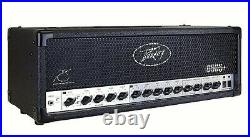
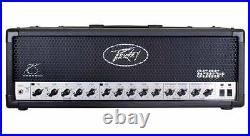
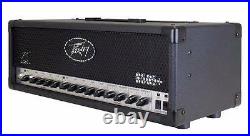
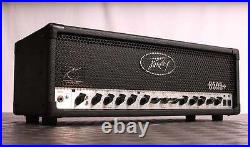
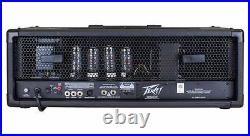
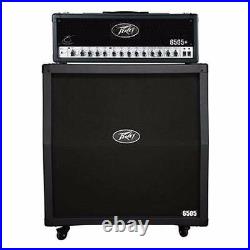
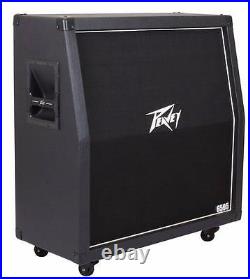
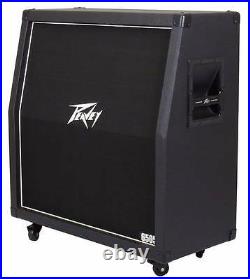
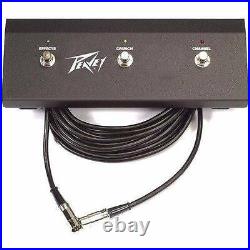

2-Channel All Tube Valve Guitar Amplifier Head w/. 6 x 12AX7 Pre-Amp Tubes. Pre & Post Gain plus.
Bright & Crunch Boost (Footwitchable), Ch2 Pre & Post Gain. As well as Two Dedicated. 3-Band Active EQ (Bass/Mid/Treble) & Presence/Resonance Controls Sets.
Effects Loop, Pre-Amp Output, Bias Test Poin t. Peavey® 2-Channel 3-Button Footswitch Channel, Crunch & Effect with LEDs plus 15ft 7-Pin DIN Cable. (FS Included if originally donored). Electric Guitar Amplifier Head w/. 4 x G6L6 Power Tubes, 6 x 12AX7 Pre-Amp Tubes, 3-Band Active EQ, Ch1 Pre & Post Gain plus Bright & Crunch Boost Switch, Ch 2 Pre & Post Gain, as well as Two Dedicated 3-Band Active EQ Control Sets & Two Dedicated Presence/Resonance Control Sets, Effects Loop, Pre-Amp Output. The undisputed go-to guitar amp series for scores of metal bands.Based on the unrepeatably awesome Eddie Van Halen Peavey® 5150MkI & MkII and the Peavey® JSX & Peavey® XXXII heads. MADE CLASSIC (Minimal Stock - 240v).
ALL Brand New PEAVEY® 6505Plus METAL Heads are now. OR you are welcome to one of our last few remaining. OR you are welcome to one of these.THE PEAVEY® 6505Plus METAL AMP HEAD. The Uncontested Sound Of Metal. Whenever it seems that the genre has been taken to the limit, a new generation comes along and redefines HEAVY! The sound of modern metal sets a new standard for brutality and aggression, and to realise this sound, the bands that have led the modern metal movement for the last two decades have turned to the only amplifier up to the task: the Peavey® 6505Series. Named in celebration of Peavey's first 40 years, the 6505Series is the undisputed go-to guitar amplifier for scores of rock, hardcore and metal bands for their raw tone, relentless power and road-proven reliability.
Is still the unquestionable choice for an ever-expanding list of endorsers. Plus features six 12AX7 Pre-Amp tubes and four 6L6GC Power Amp tubes, with presence and resonance controls and three-band EQ for taming their notorious tone.Series is the undisputed go-to guitar amp series for scores of rock and metal bands due to their raw tone, relentless power and road-proven reliability. Two distinct tube channels with footswitch control LED active indicators for each channel Bright switch for Rhythm channel Crunch switch on Rhythm channel with footswitch control Separate equalizer sections for each channel Separate power amp controls (Resonance and Presence) for each channel Separate preamp controls (Pre and Post Gain) for each channel Standby power switch Bias test points on rear panel Effects loop with footswitch control. Preamp output jack Speaker impedance selection switch (4, 8, 16 Ohm) Two parallel. Speaker output jacks 120watts output power ohm output power Metal three button footswitch with detachable 25' cable.
Six 12AX7 Pre-Amp & Four 6L6GC Power-Amp Tubes. 120watts RMS into 16, 8 or 4-Ohm Switchable. Ch1 Rhythm / Ch2 Lead.
Pre-Gain & Post-Gain (on Each Channel). Three-Band EQ - Bass / Mid / Treble (on Each Channel). Resonance & Presence Controls (on Each Channel). Rhythm Channel Footswitchable Crunch Boost. Footswitch (Included - if originally donored).
240volts AC Australian Mains Power. 16, 8 or 4-Ohm Switchable.
Vacuum Valve Tubes: Four 6L6 Power-Amp Tubes & Six 12AX7 Pre-Amp Tubes. Graphic Equalizer: Dedicated 3-Band Active EQ Controls on Each Channel (Rhythm & Lead) Bass / Middle / Treble.
Attitude: Resonance & Presence Controls on Each Channel. Rhythm Channel: Pre-Gain & Post-Gain Controls, as well as Bright/Crunch Switches. Lead Channel: Pre-Gain & Post-Gain Controls. Front Input: Guitar Input Socket. ¼ / 6.5mm TRS Mono Phono Jack.
¼ / 6.5mm TRS Phono Jacks. ¼ / 6.5mm TRS Phono Jack. Rear Out/Inputs: Effects Loop Send & Return. Voltage Input: 240voltAC IEC Input Socket to Type "I" Wall Socket 220v-230v / 240v. / 50-60Hz / 400w Cable Included. W/- 15' 7-Pin DIN Cable. Fuse: F3.15A / 250V. Unpacked: Weight - 48.30 lb (21.91 kg). Width - 26.5 (67 cm). Height - 10.3 (26 cm). Depth - 11.9 (30 cm). Packed: Weight - 57.00 lb (25.85 kg).Width - 13.25 (33.5 cm). Height - 28.75 (73 cm). Depth - 14 (35.5 cm). PEAVEY® - We Are Innovation. Driven by an unmatched legacy of innovation and a total dedication to quality and reliability, Peavey Electronics embodies the pursuit of perfection in music and audio.
It's our unifying spirit. For nearly five decades, Peavey has blazed its own path toward musical perfection. Founded by Hartley Peavey in 1965 as a one-man shop, today Peavey Electronics Corporation is one of the largest maker sand suppliers of musical instruments, amplifiers and professional audio system in the worlddistributing more than 2,000 products to more than 130 countries. Hartley has famously said, In order to be better, by definition you must be different. His quest has led to more than 180 patents and innovations in the way we hear and play music.
Hartley Peavey is not only the visionary, lead engineer and chief executive, but also the lynch pin that connects a rich history to a bright future. PEAVEY ELECTRONICS - CORPORATION HISTORY. Since its founding in 1965, our company goal has always been to build the best products available while at the same time making them affordable through the use of the most modern computer-assisted design manufacturing methods available. Exports to more than a hundred countries accounted for an estimated 40 percent of sales. The company also has manufacturing operations in Foley, Alabama, and in Corby, England, and distribution centres in The Netherlands and Canada. Its chief competitor is Yamaha, the Japanese conglomerate. Founder Hartley Peavey, whose "hometown boy makes good" story made him a local legend in Mississippi, has been the recipient of numerous awards for entrepreneurship, including the "E Star" award for success in international markets from the U. He was also inducted into Hollywood's "Rock Walk of Fame" in 1990 for his contributions to rock'n' roll music. Musical Ambitions in the 1950s. Hartley Peavey grew up in Meridian, Mississippi, and had early aspirations of becoming a rock'n' roll guitar player. As a teenager in the late 1950s, he worked in the Peavey Melody Music Store, owned by his father, J. "Mutt" Peavey, and tinkered with building amplifiers for local musicians. When, as he once confessed to Inc. Magazine, he turned out to be a "pretty lousy guitarist, " Peavey decided his future was in making amplifiers. As he later recalled in "Music and Sound's Greatest Hit, "published by Peavey Electronics for its 25th anniversary: I would build one (amplifier) a week, go out and sell it, come back and start on another one. The amplifiers were inscribed with the lightning bolt logo that Peavey had designed as a college freshman. A year later, Peavey moved the business from the family's basement to an attic in the building that had housed his father's music store.Peavey also hired his first employee, a salesman, so he could concentrate on building amplifiers. In the mid-1960s, however, there were many larger, better-known companies making amplifiers, and Peavey soon expanded into building public address systems to keep his young business afloat. In the company's 25th anniversary retrospective, Peavey explained that as I travelled and talked to music dealers, I realised there was no shortage of instrument amplifiers. But if you wanted a PA system there were essentially only two available and both were expensive systems....
Most folks think I got into the music business with guitar amps. Over the next five years, Peavey Electronics enlarged the building seven times, and having grown to more than 150 employees, in 1973 the company began construction on Plant #3, which would become its main manufacturing facility. To hire enough skilled employees, Peavey Electronics established training courses at Meridian Community College. Over the years, Peavey was often asked about his decision to keep the company in Meridian. In 1985, he told Inc. That Mississippi unfortunately runs dead last in everything. Back in 1965, when I got into this, I was too damn dumb to know it couldn't be done. " He went on to say that he had "lost count of how often he wished he had built Peavey Electronics somewhere else. In a later interview with his hometown newspaper, The Meridian Star, Peavey explained, What I tried to say in the Inc. Article was that Mississippi presented many difficulties in starting a high-tech business. And some of these difficulties exist to this day. In 1982, the City of Meridian honoured its hometown industrialist by proclaiming April 21 as Hartley Peavey Day. In the late 1980s, when the company was considering building its first U.Manufacturing facility outside of Mississippi, then-Governor Ray Mabus worked with Peavey Electronics and Meridian Community College to create The Meridian Partnership, the first private-sector use of the Job Skills Education Program, a technology and basic-skills program originally developed by the U. In the early 1990s, Peavey Electronics opened a 58,000-square-foot training centre , complete with its own recording studio, for its employees and more than 1,200 dealers. In 1993, Peavey told The News in Boca Raton, Florida, where he and his wife had a second home, People ask me why Mississippi and I say, Where do you think rock'n' roll was born? Vertical Integration in the 1970s. It was in the early 1970s that the company began the vertical integration that would make it unique among major electronic musical equipment manufacturers.
Eventually, Peavey Electronics would build everything it needed for its musical instruments, from cabinets and metal work down to making its own circuit boards and running its own advertising agency. In 1990, Peavey explained, If somebody local had been able to subcontract for me the things I needed to build amplifiers, I would probably still be using subcontractors. We had to learn to make our own chassis, our own circuit boards, and eventually everything'in-house. And while we thought it was a tremendous disadvantage, and in many ways, it was, we discovered that it was the best thing that could have happened. In the mid-1970s, Peavey Electronics also began manufacturing electric guitars, again more from necessity than design. These companies, with their immense marketing power, began encouraging dealers to sell their guitars and amplifiers as a package deal, cutting into sales of Peavey amps. Years later, Peavey recalled, When we announced that we were making guitar bodies on computer-controlled machinery, some of the most prominent names in the industry said,'Impossible.Everybody knows you can't make guitars with a computer. That was a rather simplistic attitude, we thought, because, in fact, we weren't making guitars on computers. Computer-controlled machines to make precision guitar parts to tolerances that heretofore manufacturers couldn't even think about approaching. Guitar makers are always talking about hand craftsmanship. What hand craftsmanship is, in many instances, is the ability to fit together parts that are produced with a lot of'slop' in them.
In the early 1990s, Peavey Electronics would establish a Computer-Integrated Manufacturing (CIM) system to link and track all aspects of its manufacturing, and increasingly the company was using robotics in its assembly processes. The company, however, had an unofficial no-layoffs policy and employees whose jobs were eliminated by technology were retrained for other positions.
In 1994, Jere Hess, then director of public relations, told The Meridian Star, No one in this company has ever lost their job because of automation. When Peavey Electronics celebrated its 25th anniversary in 1990, The Meridian Star published a 40-page special edition to honour the company that had become the area's largest employer. The newspaper noted that Peavey Electronics created more than 1,000 new jobs in east-central Mississippi between 1980 and 1989, including more than 850 in the Meridian area, and 73 percent of all new manufacturing jobs in Lauderdale County. Among those saluting the company was Mayor Jimmy Kemp, who said, Of course the obvious things you think about when somebody in your community employs 1,850 people is the enormous impact it has on your city, which is fantastic. I'd hate to think what we'd do without Peavey Electronics as far as our city is concerned.Peavey Electronics was then the tenth largest manufacturing employer in the state. In 1991, Peavey Electronics was one of 20 companies selected by the U. Department of Commerce to participate in a five-year program designed to stimulate export of U. As part of the program, the Department of Commerce arranged meetings between heads of the U.
Companies and Japanese officials, including Prime Minister Toshiki Kaifuand Minister of International Trade and Industry Eiichi Nakao. Peavey Electronics, which first entered the Japanese market in the mid-1970s in a short-lived relationship with industrial giant Yamaha Corporation, also agreed to participate in at least one trade show a year in Japan. Although the company contracted with other distributor, Japan was never a significant market.In 1991, President George Bush chose Peavey Electronics as the site to give a speech on economic growth. The Meridian Star noted, Hoping to pump fresh air into his sagging popularity, President Bush hailed the success of Meridian's Peavey Electronics Co. As proof that Americans can excel in a worldwide economic battle. A Brief History of Peavey Amplifiers.
A Legacy of Quality & Affordability. The story of how Peavey became one of the largest audio manufacturers in the world is one of humble beginnings and a well-deserved reputation for quality, value and innovation. Growing up as a guitar or bass player, youve probably owned or played your fair share of Peavey amps, since the companys catalogue is so affordable, diverse and well distributed.
After graduating from Mississippi State in 1965, Hartley Peavey started his company above his fathers music store, building amps one at a time. Not only is the company passionate about sound, it is equally passionate about build quality and affordability. Peaveys are known for their innovative circuitry, being built like tanks and for being affordable enough for musicians at every level, across the globe. In 1961 Hartley Peavey made his first amplifier and adorned it with the instantly recognizable company logo, which he designed himself in high school. When he launched the company four years later, Peavey produced only two amplifiers: The Musician and Dyna Bass.Both models were high-wattage, solid-state amplifiers that included simple features for the working musician. In 1973, Peavey began development on a series of vintage Fender Twin inspired amps, with 6L6 power tubes and two 6C10 pre-amp tubes. These amps had a different sonic signature than the Twin and had their own unique sound.
Since solid state was all the rage back in the 1970s, later versions capitalized on new technology, which enabled the combination of solid-state pre-amps with tube power amps. The vintage series was the precursor to the now popular all-tube Classic Series®, which features an EL84 power section that effectively combines classic Vox- and Fender-type tones in one convenient and versatile amp for use in many different styles of music.
With solid state amps becoming increasingly popular in the 70s and early 80s, Peavey developed what is arguably its most famous solid-state amp: The Bandit®. Conceived in 1980, the Bandit since has gone through many revisions and Bandit.
S still are being produced today with Peaveys own TransTube. This innovative feature emulates the sound and feel of a tube amp using solid state power. Peavey accomplished this by modelling the overload characteristics of the amp and transformer as well as emulating the sound of asymmetrically clipping tubes. Early model Bandits are instantly recognizable by their multi-coloured knobs and silver panels adorning the sides of the grill cloth. Varying in wattage over time, the Bandit has become a reliable tool in the solid-state amp lovers arsenal. More Gain for 80s Metal Players. When hair metal first hit in the 80s, players required more gain for new playing techniques, such as two-handed tapping and sweep picking. Marshall was ahead of the curve for this particular sound with the coveted JCM800 2203, but Peavey offered its take on that circuit with the Butcher and VTM series. Instead of Marshall's usual EL34 tubes, both series of Peavey amps used 6L6 power tubes, which yielded a darker sound and a less apparent upper-mid presence. Many compare the VTM to a hot-rodded JCM800 and the Butcher to a normal JCM800, but even though these amps may share similar tonal characteristics, they are definitely their own beasts. These amps are extremely versatile and can be bought for much less than comparable competitors.In the early 90s, more players began demanding even more gain, power and options, and Peavey moved to the front of the pack, via the three-channel Ultra Plus. Could cover any genre of music with its crisp-and-spanky clean channel for country; crunch channel for rock's cutting mid range; and ultra-channel for searing leads and metal riffs.
Using an active EQ section, the user could boost or cut any frequency with precision and dial in his own desired tone. Peavey seems to favour 6L6 power tubes, and at 120 watts this head could do the job for any situation.
It was a precursor to the Triple XXX. Series, which was a slightly modified version of the Ultra Plus, but it featured updated aesthetics, including a metal face plate akin to a Mesa Triple Rectifier.
Peavey since has come out with the Triple XXX. II, which features switchable power tubes from the stock EL34s to 6L6s.
The Most Famous of Them All. Was unleashed in 1992 after a two-year collaboration between the creative minds of amp designer James Brown and guitarist Eddie Van Halen.Featuring two channels, a 120-watt all-tube 6L6 power section and a shared EQ, the 5150. Was able to produce a variety of rock and metal tones. The rhythm channel could be set clean or crunchy, but the lead channel is what this amp is famous for.
With its super high-gain sound, it could be used for anything from tight and aggressive metal riffs to blistering lead tones. This led to the 5150.II with separate EQs for each channel, which made the amp even more versatile. In 2004, EVH parted ways with Peavey and the amp was re-branded as the 6505. + also known as the 6505. Plus, along with the 6534 and 6534+ (also known as the 6534Plus), which feature an EL34 power section for a more British flavour.
Since its creation, Peavey strives to make powerful, affordable amplifiers so that every musician can have the means to own one and the privilege to play through one. We are the NSW Mid-North Coast Franchise Dealer for these (and more) quality musical instruments & equipment plus loads more guitar, drum, keyboard, recording, and live brands.
N E W T ON E M U S I C. For more than 25 years at N E W T ON E M U S I C we provide.
1-YEAR back to base (excluding valves) on USED items. LAYBY without time limits &receipts showing remaining balance. NO INTERESTED EVER Finance available. Groundwater's Guitar School Inc.
58 Commerce Street, Taree NSW 2430. (BSB: 0 6 2 6 0 3 / ACC: 1 0 1 7 1 0 9 2). The item "PEAVEY 6505Plus METAL 120w 2-Channel All Valve Guitar Amplifier Head USED" is in sale since Friday, February 7, 2020. This item is in the category "Musical Instruments\Guitars & Basses\Guitar Amplifiers". The seller is "newtonemusic" and is located in Taree, New South Wales.
This item can be shipped worldwide.
- Number of Channels: 2
- Model: PEAVEY® 6505Plus METAL
- Country/Region of Manufacture: United States
- Custom Bundle: No
- Impedance: 4-8-16 Ohm Switchable
- Product Line: PEAVEY® 6505Series
- Venue Type: Recording & Performance
- Modified Item: No
- RMS Power: 120w
- Amplifier Technology: Vacuum Tube
- Compatible Guitar: Electric Guitar Amplifier
- Instrument: Electric Guitar Amplifier
- MPN: 00575680
- Power: 120w
- Amplifier Type: Amplifier Head
- Brand: PEAVEY®
- Suitable For: Performance, Touring, Recording
